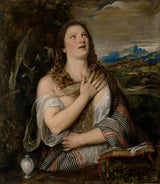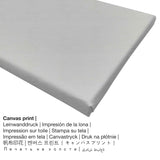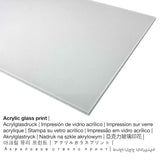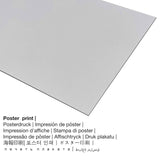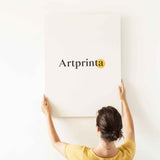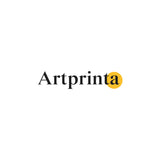Titian, 1565 - Magdalene penitent - mbipụta nka mara mma
Ụtụ gụnyere. Mbupu gbakọrọ na ndenye ọpụpụ.
Nkọwa nka nka izizi dị ka webụsaịtị ihe ngosi nka nyere (© Nwebiisinka - nke J. Paul Getty Museum - www.getty.edu)
This painting of a repentant Mary Magdalene lifting her teary eyes to heaven was meant to inspire a greater spiritual devotion at a time when Catholicism was being challenged by the Protestant reformation. Owing to the popularity of the subject, Titian and his workshop made at least seven versions of this painting. X-rays of the painting revealed that Titian made numerous changes to the composition, suggesting that he used this canvas to work out his ideas over a considerable period of time. This Getty painting is unique because it is the only composition that shows the Magdalene's Bible resting on a cloth-covered support rather than a skull--a symbol used to invite contemplation of death.
Images of Mary Magdalene, the fallen woman whom Jesus found worthy to redeem and who would spend the rest of her life in solitude to atone for her sins, were especially prevalent during the Counter-Reformation, a period of devout Catholicism that lasted from approximately 1540 to 1640. Upon seeing Titian's conception of Mary Magdalene, Giorgio Vasari declared that the picture "profoundly stirs the emotions of all who look at it; and, moreover, although the figure Mary Magdalene is extremely lovely it moves one to thoughts of pity rather than desire."
Ozi ahia Izugbe
The Penitent Magdalene was created by Titian in 1565. Ihe ọzọ, a artwork nwere ike na-ele na nchịkọta nke Ụlọ ihe ngosi nka nke J. Paul Getty, which is part of the J. Paul Getty trust and is one of the world's largest arts organizations worldwide. It seeks to inspire curiosity about, and enjoyment and understanding of, the visual arts by collecting, conserving, exhibiting, and interpreting works of art of outstanding quality and historical importance.. This classic art work of art, which is part of the public domain is being included, courtesy of The J. Paul Getty Museum.Creditline of the artwork: . Furthermore, alignment is in Eserese format na nwere akụkụ ruru nke 1: 1.2, nke pụtara na ogologo bụ 20% mkpụmkpụ karịa obosara. Titian was a painter from Italy, whose art style can be classified as High Renaissance. The European painter lived for a total of 99 years - born in 1477 in Pieve di Cadore and deceased in 1576 in Venice.
Họrọ ihe kacha amasị gị
Maka mbipụta nka ọ bụla anyị na-enye ụdị nha & ihe dị iche iche. Họrọ n'ime nhọrọ ngwaahịa ndị a ugbu a ka ị kwekọọ na mmasị gị na nha na akụrụngwa:
- Mbipụta kanvas: The canvas print, not to be confused with a canvas painting, is a digital copy applied onto canvas. Canvas prints are relatively low in weight, meaning that it is easy and straightforward to hang the Canvas print without the use of extra wall-mounts. That is why, canvas prints are suitable for any kind of wall.
- Mbipụta aluminom (aluminium dibbond): This is a metal print manufactured on aluminium dibond with a true depth, which makes a fashionable impression with a surface , which is non-reflective. For our Print On Aluminum Dibond, we print the chosen artpiece right onto the surface of the aluminum composite. This direct print on aluminium is one of the most popular entry-level products and is an extremely contemporary way to display artworks, because it draws attention on the whole artwork.
- Poster (akwa akwa akwa): A poster print is a UV printed canvas with a fine structure on the surface. It is perfectly suited for framing your art replica using a special frame. Please bear in mind, that depending on the absolute size of the canvas poster print we add a white margin of approximately 2-6cm around the artwork to facilitate the framing with your custom frame.
- Glass acrylic e biri ebi (nwere ezigbo mkpuchi iko): An print on acrylic glass, which is sometimes named as a UV print on plexiglass, will change the original work of art into home décor. Your favorite artwork will be made with the help of state-of-the-art UV direct printing technology. With an acrylic glass art print contrasts as well as minor painting details become visible with the help of the delicate gradation of the print.
Tebụl nkọwa omenkà
| Ihe nkiri: | Titian |
| okike nke onye nka: | nwoke |
| Obodo onye nka: | Italian |
| Ọrụ: | onye na-ese ihe |
| Mba onye si: | Italy |
| Otu nka: | nna ukwu ochie |
| Ụdị nka: | Akwa Renaissance |
| Akwụsị: | 99 afọ |
| Afọ ọmụmụ: | 1477 |
| Ebe amụrụ onye: | Pieve di Cadore |
| Afọ nwụrụ: | 1576 |
| Nwụrụ na (ebe): | Venice |
Data ndabere gbasara ọrụ nka
| Aha nka: | "The Penitent Magdalene" |
| nhazi ọkwa: | sere |
| Okwu nche anwụ: | nka ochie |
| Century: | 16th narị afọ |
| Afọ nka: | 1565 |
| Afọ nka: | ihe karịrị afọ 450 |
| Ụlọ ihe ngosi nka / mkpokọta: | Ụlọ ihe ngosi nka nke J. Paul Getty |
| Ebe ngosi nka: | Los Angeles, California, Njikota Obodo Amerika |
| Weebụsaịtị ihe ngosi nka: | Ụlọ ihe ngosi nka nke J. Paul Getty |
| Akwụkwọ ikike nka: | ngalaba ọha |
| Site n'aka: | Ụlọ ihe ngosi nka nke J. Paul Getty |
Banyere ihe a
| Nkewa bipụta: | ezi nka mmeputakwa |
| Usoro mmeputakwa: | dijitalụ mmeputakwa |
| Production usoro: | Mbipụta UV ozugbo (mbipụta dijitalụ) |
| Ihe ngosi: | emere na Germany |
| Ụdị ngwaahịa: | na mmepụta ihe |
| Ojiji ngwaahịa: | nchịkọta nka (mmeputakwa), foto mgbidi |
| Nhazi onyonyo: | nhazi ihe osise |
| Ụdị anya: | 1: 1.2 (ogologo: obosara) |
| Akụkụ akụkụ pụtara: | ogologo bụ 20% mkpụmkpụ karịa obosara |
| Akwa mmeputakwa dị: | Mbipụta iko acrylic (nwere ezigbo mkpuchi iko), mbipụta ọla (aluminium dibond), mbipụta akwa akwa, mbipụta akwụkwọ mmado (akwụkwọ kwaaji) |
| Mpempe akwa akwa (akwa akwa na etiti ihe ndọtị) nha: | 50x60cm - 20x24", 100x120cm - 39x47", 150x180cm - 59x71" |
| Acrylic glass print (nwere ezigbo mkpuchi iko) nhọrọ: | 50x60cm - 20x24", 100x120cm - 39x47", 150x180cm - 59x71" |
| Mbipụta akwụkwọ mmado (akwụkwọ kwaaji): | 50x60cm - 20x24", 100x120cm - 39x47" |
| Mbipụta aluminom: | 50x60cm - 20x24", 100x120cm - 39x47" |
| Nhazi mbipụta nka: | biko buru n'uche na mmeputakwa a enweghi okpokolo agba |
Nkwupụta iwu: We try in order to describe our art products in as much detail as we can and to illustrate them visually in our shop. Although, the colors of the print materials and the imprint can diverge somehwat from the image on the device's screen. Depending on the screen settings and the condition of the surface, colors can unfortunately not be printed as exactly as the digital version shown here. Considering that our art prints are printed and processed by hand, there might as well be minor differences in the motif's size and exact position.
© Nchekwa ikike nwebisiinka - www.artprinta.com (Artprinta)

